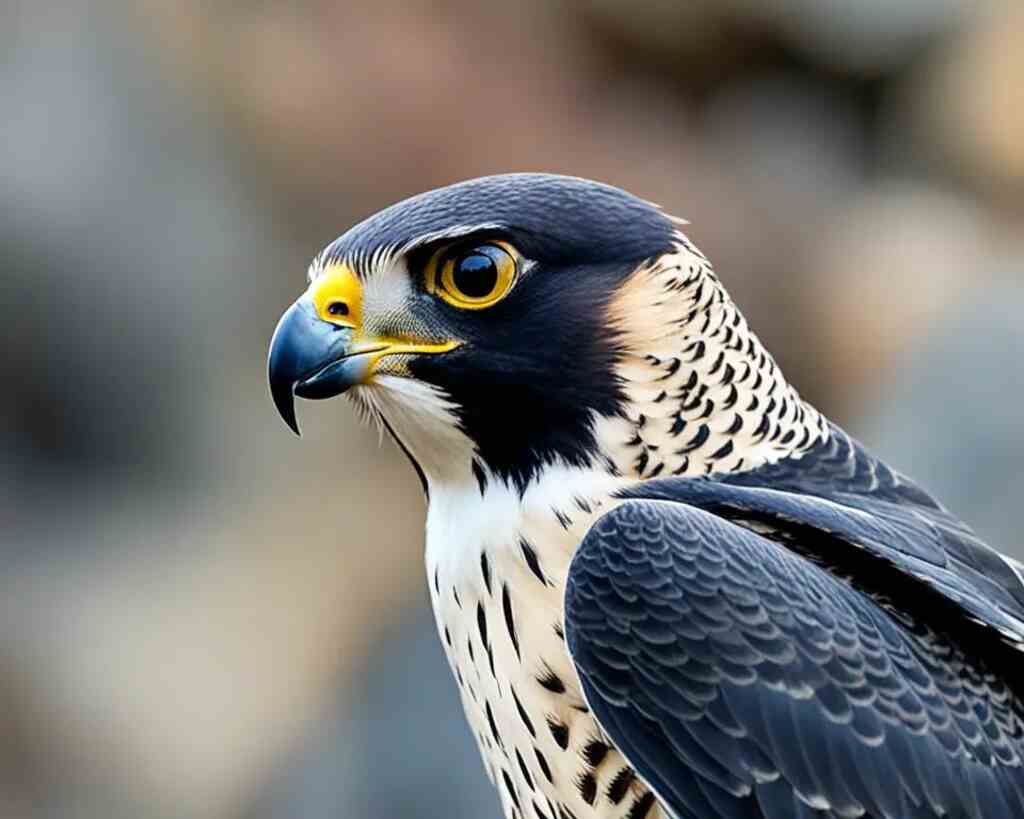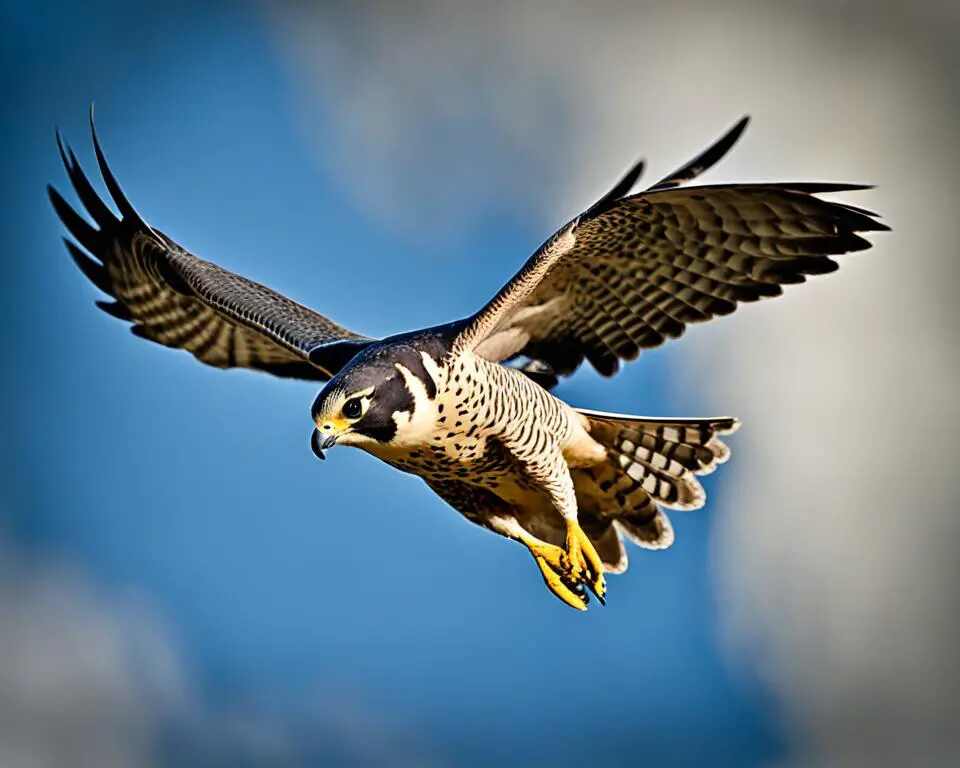Welcome to the ultimate guide to the peregrine falcon, a majestic and awe-inspiring bird of prey. Have you ever wondered what makes this falcon species so remarkable? From its incredible speed to its hunting prowess, the peregrine falcon is truly a master of the skies. Join me as we explore the fascinating world of this extraordinary bird and uncover the secrets that make it one of nature’s most intriguing creatures.
Table of Contents
- 1 Discovering the Peregrine Falcon: A Bird of Many Names
- 2 Majestic in Flight: Understanding the Peregrine Falcon’s Aerial Abilities
- 3 The Life Cycle of the Peregrine Falcon: From Egg to Aerial Predator
- 4 Peregrine Falcon Diet: An Aerial Hunter’s Feast
- 5 Conservation Triumphs: The Resilience and Recovery of the Peregrine Falcon
- 6 Conclusion
- 7 Source Links
- 8 Author
Key Takeaways:
- The peregrine falcon is a falcon species and a bird of prey
- This bird is known for its incredible speed and agility
- The peregrine falcon employs unique hunting techniques
- It migrates across diverse habitats
- Conservation efforts play a crucial role in preserving the peregrine falcon’s future
Discovering the Peregrine Falcon: A Bird of Many Names
The Peregrine Falcon is a fascinating bird with a rich history and diverse identities. Known as the fastest bird and a formidable bird of prey, it has captured the admiration of bird enthusiasts and researchers alike. But did you know that the peregrine falcon also goes by other names?
One of its alternative names is the duck hawk, which refers to its remarkable hunting prowess. This name highlights the bird’s ability to prey on ducks and other waterfowl, showcasing its agility and speed in aerial pursuits.
Another common moniker for the peregrine falcon is simply “peregrine,” derived from the Latin word “peregrinus,” meaning “wanderer” or “pilgrim.” This name alludes to the bird’s extensive migratory patterns, where it travels great distances in search of suitable habitats and prey.
These various names demonstrate the significance and versatility of the peregrine falcon in different contexts. It reflects the awe-inspiring qualities of this avian species, elevating it to a symbol of power, speed, and adaptability in the natural world.
| Name | Meaning |
|---|---|
| Peregrine Falcon | The species name, highlighting its distinctive characteristics. |
| Duck Hawk | Emphasizes the hunting abilities of the falcon. |
| Peregrine | Reflects the bird’s migratory nature and wandering traits. |
Majestic in Flight: Understanding the Peregrine Falcon’s Aerial Abilities
The peregrine falcon is renowned for its remarkable flight capabilities, making it one of the most awe-inspiring birds in the world. From its record-breaking speeds to its unique hunting techniques and migration patterns, this aerial predator never fails to captivate and amaze.
Record-Breaking Speeds with the Fastest Bird in the Sky
When it comes to speed, the peregrine falcon stands above all others, earning its place as the fastest bird in the sky. Soaring through the air, it can reach incredible speeds of up to 240 miles per hour when diving to capture its prey. This extraordinary velocity is made possible by the bird’s streamlined body, long wings, and specialized feathers that provide optimal aerodynamic performance. The peregrine falcon’s speed enables it to execute precise maneuvers in flight, ensuring a successful hunt.
Unique Hunting Techniques of an Agile Raptor
The peregrine falcon’s hunting capabilities are as impressive as its speed. This falconry bird utilizes a range of techniques that highlight its agility and stealth. One remarkable method is its stoop, a high-speed dive that enables the peregrine falcon to strike its prey with remarkable force. During the stoop, the falcon tucks its wings to reduce drag, using gravity to accelerate its descent. The accuracy and power of this hunting maneuver are unparalleled, allowing the peregrine falcon to quickly and effectively capture its prey.
Migration Patterns Across Diverse Habitats
In addition to its aerial prowess, the peregrine falcon is also known for its remarkable migration patterns. These birds can be found in a variety of habitats across the globe, from the Arctic tundra to the deserts of Africa. They undertake long journeys, covering thousands of miles each year, in search of suitable breeding grounds and ample food sources. The peregrine falcon’s ability to navigate and adapt to different environments during its migration showcases its resilience and resourcefulness.
The Life Cycle of the Peregrine Falcon: From Egg to Aerial Predator
The life cycle of the peregrine falcon is a fascinating journey from the moment of egg formation to its development into a skilled aerial predator. Understanding the various stages of the falcon’s life provides valuable insights into its nesting habits, egg incubation process, and the growth and maturation of the peregrine falcon chicks.
At the heart of this life cycle lies the peregrine falcon’s egg. Female peregrines typically lay three to four eggs per clutch, and both parents take turns incubating them for about 30 days. During this incubation period, the eggs are kept warm and protected, ensuring the proper development of the embryos inside. The nesting habits of peregrine falcons often involve selecting high cliffs or tall structures as nesting sites, providing them with a safe and elevated location to raise their young.
Once the eggs hatch, the peregrine falcon chicks emerge, fragile and vulnerable. However, their journey to becoming fierce aerial predators begins. The parents provide constant care and protection, feeding the chicks a diet consisting mostly of small birds. As the chicks grow, their bodies undergo remarkable changes, enabling them to hunt and capture prey themselves. The young falcons develop their aerial skills, gradually honing their speed and agility, becoming efficient hunters in their own right.
Peregrine Falcon Diet: An Aerial Hunter’s Feast
As an aerial hunter, the peregrine falcon has a diverse and dynamic diet that showcases its remarkable hunting abilities. This majestic bird of prey feeds on a variety of prey, ranging from small birds to larger species, making it a formidable predator in the skies.
One of the peregrine falcon’s primary sources of food is other birds. With its exceptional speed and agility, the peregrine falcon is capable of targeting and capturing birds mid-flight. It employs a hunting strategy known as the stoop, where it dives at astonishing speeds to overtake its prey. This precision hunting technique allows the peregrine falcon to strike with incredible accuracy, ensuring a successful kill.
In addition to birds, the peregrine falcon’s diet also includes small mammals such as bats and rodents. These agile hunters are able to pursue and capture these ground-dwelling creatures with their sharp talons and keen eyesight. Their strong beaks are perfectly adapted for tearing into the flesh of their captured prey.
Table:
| Prey | Description |
|---|---|
| Small Birds | Includes species such as sparrows, finches, and warblers. |
| Larger Birds | Includes medium-sized birds like pigeons, ducks, and grouse. |
| Bats | Peregrine falcons catch bats in mid-flight, using their swift and precise hunting skills. |
| Rodents | These include mice, squirrels, and other small mammals that the falcons are able to locate and capture on the ground. |
The peregrine falcon’s adaptability and versatility when it comes to its diet are essential for its survival. These birds have the ability to hunt and thrive in various environments, from open grasslands to densely populated urban areas. Their diet reflects their adaptability to diverse habitats and their ability to find sustenance in different ecosystems.
Through their prowess as aerial hunters, the peregrine falcons play a crucial role in maintaining the delicate balance of nature. Their hunting skills not only enable their survival but also contribute to the overall health of ecosystems they inhabit. The peregrine falcon’s ability to feast on a wide range of prey ensures that populations of smaller birds and mammals remain in check, preventing an overabundance that could disrupt the ecological equilibrium.
Conservation Triumphs: The Resilience and Recovery of the Peregrine Falcon
The peregrine falcon has faced numerous challenges over the years, with its population declining due to various factors. However, thanks to dedicated conservation efforts, this magnificent bird has made a remarkable recovery and is now considered a conservation success story.
Hurdles Overcome: The DDT Crisis and Endangered Species Act
One of the major hurdles that the peregrine falcon had to overcome was the devastating impact of the pesticide DDT (dichlorodiphenyltrichloroethane). DDT contamination caused thinning of the falcon’s eggshells, leading to a decline in reproductive success. In the 1970s, the peregrine falcon was listed as an endangered species under the Endangered Species Act, which provided legal protection and paved the way for recovery efforts.
The ban on DDT and the implementation of the Endangered Species Act enabled conservationists to focus on restoring the peregrine falcon population. Through captive breeding and reintroduction programs, falconers, biologists, and volunteers worked together to release falcons back into the wild, ensuring their survival and fostering population growth.
Modern Conservation Efforts: Urban Nesting and Wildlife Education
In recent years, conservation efforts have evolved to address the changing needs of the peregrine falcon. As urbanization continues to encroach upon natural habitats, peregrine falcons have adapted to nesting on tall buildings and skyscrapers in cities. This urban nesting phenomenon has provided unique wildlife conservation opportunities, captivating bird watchers and wildlife photographers who can observe these magnificent birds in their urban habitats.
Alongside urban nesting, wildlife education programs have played a crucial role in raising awareness about the importance of peregrine falcon conservation. These programs emphasize the significance of protecting the falcon’s natural habitat and highlight the role of the peregrine falcon as an indicator species for the overall health of ecosystems.
Continuing Challenges for Ensuring the Peregrine’s Future
Although the peregrine falcon has made a remarkable recovery, ongoing efforts are required to ensure its long-term survival. Habitat loss and fragmentation, climate change, and other human activities continue to pose threats to this iconic bird species.
Conservationists and researchers are actively working to monitor and protect the peregrine falcon’s habitat, identify and mitigate threats, and engage with local communities to foster a sense of stewardship for these birds. By promoting responsible bird watching and wildlife photography, enthusiasts can contribute to the conservation of the peregrine falcon while enjoying the beauty of these birds in their natural environment.
Together, these efforts will help safeguard the peregrine falcon for future generations, ensuring that this remarkable bird continues to soar in the skies and inspire awe and admiration.
Conclusion
Throughout this article, we have explored the incredible peregrine falcon, a fascinating bird of prey with remarkable aerial abilities. From its record-breaking speeds as the fastest bird in the sky to its unique hunting techniques, the peregrine falcon showcases the prowess and agility of an apex predator.
Understanding the life cycle of the peregrine falcon, from egg to aerial predator, has shed light on its nesting habits and growth process. We have also seen its diverse diet, ranging from smaller birds to larger species, and the hunting strategies it employs to capture its prey.
However, it is essential to acknowledge the importance of conservation efforts to protect the peregrine falcon and ensure its future survival. Facing challenges such as the DDT crisis and habitat loss, the peregrine falcon persevered through dedicated conservation initiatives and the implementation of the Endangered Species Act. Modern efforts, including urban nesting and wildlife education programs, have further contributed to its resilience and recovery.
In conclusion, the peregrine falcon stands as a testament to the wonders of nature. Its impressive aerial abilities and role as a bird of prey showcase the awe-inspiring diversity of the natural world. By prioritizing conservation, we can continue to marvel at the beauty and grace of the peregrine falcon for generations to come.




